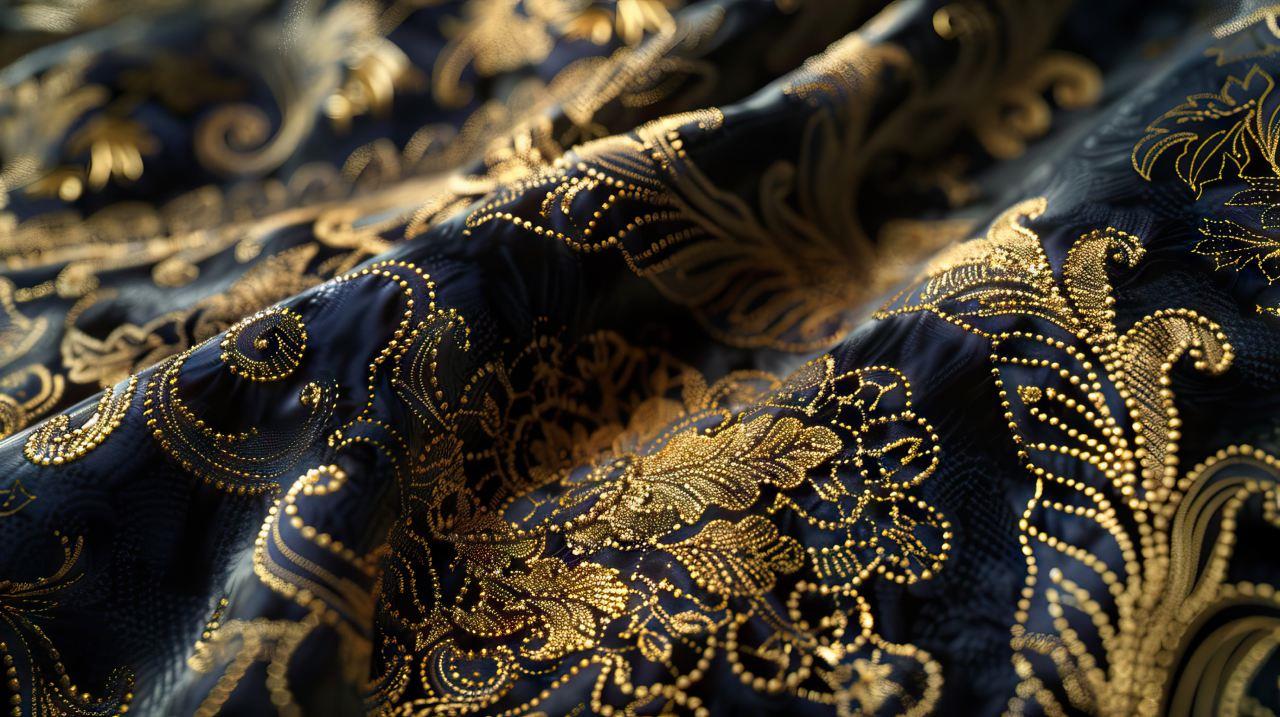The Mughals, with their diverse cultural influences, introduced a rich array of fabrics to the Indian subcontinent. Silk, the fabric of royalty, was a particular favourite. Sourced from various regions, including China and Persia (present day Iran), silk was used to create a wide range of garments, from flowing robes to intricate shawls. The Mughals also favoured muslin, renowned for its delicate and airy nature. The fine muslins of Dhaka, often described as ‘woven air’, were particularly prized. Velvet, with its rich and opulent texture, was another popular choice, especially for formal wear and ceremonial garments. Brocade, a woven fabric characterised by intricate patterns and designs, was also a staple of the Mughal wardrobe. It was often used for royal robes and ceremonial attire. While not as luxurious as silk or velvet, cotton was widely used by the common people due to its affordability and comfort.
The Mughals were masters of textile embellishment, developing and refining a variety of techniques that continue to be admired today. Zardozi, an intricate form of embroidery involving gold and silver threads, was used to create elaborate patterns and motifs on royal garments and accessories. Chikankari, a delicate white-on-white embroidery technique originating from Lucknow, was popularised by the Mughals. It involved creating intricate floral and geometric patterns on muslin and other fine fabrics. Kalamkari, a hand-painted textile technique originating from Andhra Pradesh, was another favourite of the Mughals. It involved using natural dyes to create intricate designs on cotton and silk fabrics. Pashmina, a fine wool fabric sourced from Kashmir, was prized for its warmth and softness. It was often woven into intricate shawls and scarves, adorned with delicate embroidery.
A Royal Affair: Textiles for the Elite
The Mughal royals, with their access to the finest materials and the most skilled artisans, favoured the most luxurious fabrics and intricate embellishments. Silk, velvet, and brocade were the fabrics of choice, adorned with zardozi, chikankari, and other elaborate techniques. These garments were often worn on special occasions, such as festivals, weddings, and royal ceremonies. The Mughal emperors and their families were also patrons of the arts, and they commissioned the creation of exquisite textiles for their personal use and as gifts for foreign dignitaries. These textiles often featured intricate designs and motifs inspired by Persian and Indian art and culture.
The Common Touch: Textiles for the Masses
While the Mughal royals enjoyed the luxury of fine fabrics and intricate embellishments, the common people also had access to a variety of textiles, albeit of a more modest nature. Cotton was the most widely used fabric, as it was affordable and comfortable. It was often woven into simple garments, such as dhotis, sarees, and kurtas. The common people also used a variety of dyeing and printing techniques to decorate their fabrics. Kalamkari, for example, was not only popular among the royals but also among the common people. It was used to create colourful and vibrant designs on cotton fabrics, which were used to make a variety of garments.
The Mughal Legacy: A Lasting Impact
The Mughal Empire, which lasted for over three centuries, had a profound impact on the development of Indian textiles. The Mughals introduced new fabrics, techniques, and designs, which continue to influence Indian textile traditions to this day. Their legacy can be seen in the rich and diverse textile heritage of India, which is celebrated worldwide. The Mughal period also saw the development of a thriving textile industry, with centres of production emerging in various parts of the country. These centres produced a wide range of textiles, from fine muslins to heavy brocades, catering to the needs of both the domestic and international markets. The Mughal influence on Indian textiles can still be seen today in the intricate designs and vibrant colours of Indian fabrics. The techniques developed during the Mughal period, such as zardozi, chikankari, and kalamkari, continue to be pursued by artisans across India.
The Role of Women in Textile Production
Women played a significant role in the textile production process during the Mughal period. They were involved in various stages, from spinning and weaving to dyeing and embroidery. The skills of female artisans were highly valued, and many were employed in royal workshops and private households to create exquisite textiles. The Mughal emperors often patronised female artisans, providing them with resources and opportunities to develop their skills. This led to the emergence of a class of skilled female artisans who were able to create some of the finest textiles of the period.
The Art of Dyeing and Printing
Dyeing and printing were essential techniques used to enhance the beauty and value of Mughal textiles. The Mughals were skilled in a variety of dyeing techniques, including natural dyeing and resist dyeing. Natural dyes were extracted from plants, animals, and minerals, and were used to create a wide range of colours. Resist dyeing techniques, such as tie-dye and block printing, were also popular during the Mughal period. These techniques involved applying a resist to the fabric before dyeing, which prevented the dye from penetrating certain areas. This allowed artisans to create intricate patterns and designs on the fabric.
The Influence of Persian and Central Asian Textile Traditions
The Mughals, with their Persian and Central Asian heritage, brought with them a rich textile tradition. This influence can be seen in the intricate designs and motifs used in Mughal textiles, as well as in the techniques used to create them. Persian carpets, with their elaborate designs and vibrant colours, were a major influence on Mughal textile production. The Mughals also adopted Persian techniques for weaving and embroidery, such as zardozi and chikankari.
The Impact of Trade on the Textile Industry
Trade played a crucial role in the development of the Mughal textile industry. The Mughals established a vast network of trade routes, connecting India to other parts of the world. This allowed Indian textiles to reach new markets and generate significant wealth for the empire. The demand for Indian textiles, particularly fine muslins and embroidered fabrics, increased significantly during the Mughal period. This led to the growth of textile production centres in various parts of the country, such as Bengal, Gujarat, and Kashmir. The Mughal emperors also encouraged foreign traders to come to India and establish their businesses. This led to the influx of new ideas and technologies, which helped to further develop the Indian textile industry.
The Decline of the Mughal Empire and the Textile Industry
The decline of the Mughal Empire in the 18th century had a significant impact on the textile industry. The political instability and economic decline that followed the fall of the empire led to a decline in the demand for Indian textiles. The British East India Company, which had established a strong presence in India, also played a role in the decline of the Indian textile industry. The company began to export large quantities of cheap, machine-made textiles to India, which undercut the market for Indian handloom textiles. Despite these challenges, the legacy of Mughal textiles continues to inspire and influence the world of fashion and design. The intricate designs, vibrant colours, and exquisite craftsmanship of Mughal textiles are still admired today, and they continue to be a source of inspiration for contemporary designers.

20250117163420.png)





20250219104125.png)
Comments